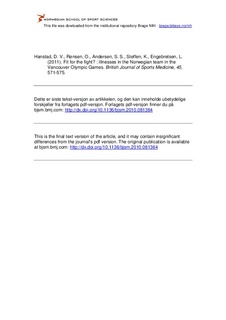| dc.contributor.author | Hanstad, Dag Vidar | |
| dc.contributor.author | Rønsen, Ola | |
| dc.contributor.author | Andersen, Svein S. | |
| dc.contributor.author | Steffen, Kathrin | |
| dc.contributor.author | Engebretsen, Lars | |
| dc.date.accessioned | 2011-09-01T07:35:50Z | |
| dc.date.available | 2011-09-01T07:35:50Z | |
| dc.date.issued | 2011-03-09 | |
| dc.identifier | Seksjon for kultur og samfunn / Department of Cultural and Social Studies | |
| dc.identifier.citation | British Journal of Sports Medicine. 2011, 45, 571-575 | en_US |
| dc.identifier.issn | 0306-3674 | |
| dc.identifier.uri | http://hdl.handle.net/11250/170775 | |
| dc.description | I Brage finner du siste tekst-versjon av artikkelen, og den kan inneholde ubetydelige forskjeller fra forlagets pdf-versjon. Forlagets pdf-versjon finner du på bjsm.bjm.com: http://dx.doi.org/10.1136/bjsm.2010.081364 / In Brage you'll find the final text version of the article, and it may contain insignificant differences from the journal's pdf version. The original publication is available at bjsm.bjm.com: http://dx.doi.org/10.1136/bjsm.2010.081364 | en_US |
| dc.description.abstract | Background The development of strategies to prevent illnesses before and during Olympic Games provides a basis for improved health and Olympic results.
Objective (1) To document the efficacy of a prevention programme on illness in a national Olympic team before and during the 2010 Vancouver Olympic Winter Games (OWG), (2) to compare the illness incidence in the Norwegian team with Norwegian incidence data during the Turin 2006 OWG and (3) to compare the illness incidence in the Norwegian team with illness rates of other nations in the Vancouver OWG.
Methods Information on prevention measures of illnesses in the Norwegian Olympic team was based on interviews with the Chief Medical Officer (CMO) and the Chief Nutrition and Sport Psychology Officers, and on a review of CMO reports before and after the 2010 OWG. The prevalence data on illness were obtained from the daily reports on injuries and illness to the International Olympic Committee.
Results The illness rate was 5.1% (five of 99 athletes) compared with 17.3% (13 out of 75 athletes) in Turin (p=0.008). A total of four athletes missed one competition during the Vancouver Games owing to illness, compared with eight in Turin. The average illness rate for all nations in the Vancouver OWG was 7.2%.
Conclusions Although no definite cause-and-effect link between the implementation of preventive measures and the prevalence of illness in the 2010 OWG could be established, the reduced illness rate compared with the 2006 OWG, and the low prevalence of illnesses compared with other nations in the Vancouver OWG suggest that the preparations were effective. | en_US |
| dc.language.iso | eng | en_US |
| dc.publisher | BMJ | en_US |
| dc.subject | Olympic Winter Games (21st : 2010 : Vancouver, B.C.) | en_US |
| dc.subject | sports teams | en_US |
| dc.subject | health | en_US |
| dc.subject | athletes | en_US |
| dc.subject | diseases | en_US |
| dc.subject | medicine, preventive | en_US |
| dc.title | Fit for the fight? illnesses in the norwegian team in the Vancouver olympic games | en_US |
| dc.type | Journal article | en_US |
| dc.type | Peer reviewed | en_US |
| dc.subject.nsi | VDP::Social science: 200::Social science in sports: 330::Other subjects within physical education: 339 | en_US |
| dc.source.pagenumber | 571-575 | en_US |
